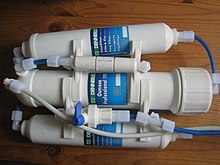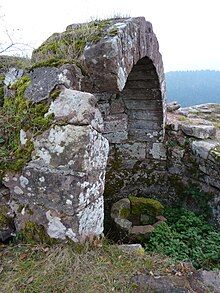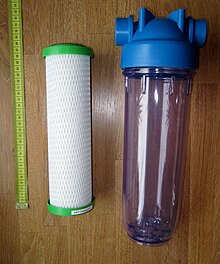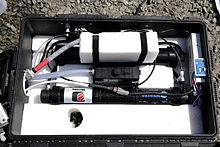Water filter
A water filter is a device used to improve the quality of the water. This improvement generally consists in removing particles such as turbid matter or microorganisms or undesirable substances dissolved in the water or reducing their concentration .
A distinction must be made between purely physical filters that work mechanically by means of sieves and those that use chemical-physical effects to remove dissolved substances:
- The first group includes B. gravel , stone, plastic, metal or sand filters , etc. as well as ultra or microfiltration . In these systems, mainly particulate ingredients are separated that are too large to pass through the filter bed or the membrane (sieve effect).
- In the water dissolved substances are, however, in the case of organic substances by adsorption , for example on. Activated carbon removed from the water or if it is ion is, by ion exchange of ion-exchange materials and, for example calcium - or magnesium - cations .
The diffusion membranes of nanofiltration and reverse osmosis occupy a certain special position : With these membranes it is possible to remove a large part of the dissolved organic constituents as well as a large part of the dissolved salts (ions) from the water.
Drinking water filter


The drinking water supplied in Germany must meet the requirements of the Drinking Water Ordinance (TrinkwV 2001) and is regularly examined in accordance with the requirements of the TrinkwV. This guarantees a relatively good water quality across the board. Substances that have not yet been regulated by the Drinking Water Ordinance and therefore not investigated can be found primarily in surface water and, more rarely, in groundwater. With advances in analytical technology and various screening tests, such substances are occasionally found in surface water and sometimes in drinking water. If this is the case, these substances are always evaluated by the Federal Environment Agency or the drinking water commission, with corresponding recommendations for the water suppliers. Nevertheless, not least because of the so-called analytical window, residual risks cannot be ruled out with certainty, as it is not possible to test a water for really "all" substances. Such residual risks can be classified as very low, at least in Germany. Nevertheless, there is a need for some people to treat the water additionally with additional filter devices and thus, for example, to remove dissolved organic substances from the water.
Furthermore, comparatively hard water with a drinking water hardness of over 12 ° dH or 21 ° fH is fed into some of the drinking water supply areas . This water hardness is perceived as disadvantageous by some of the population, as the hardness leads on the one hand to an increased effort in the maintenance of hot water devices and on the other hand to an increased consumption of detergents and cleaning agents. Last but not least, high water hardness can affect the taste of beverages such as tea or coffee.
Place of water treatment
Waterworks
Coarse filter in the home installation
To protect against the entry of any parts and substances released from the local supply network (e.g. rust particles from older cast iron pipes ), coarse filters e.g. B. be installed in front of the water meter at the main tapping point.
Water treatment in the household
In order to protect yourself from substances that may be present in drinking water, it is sufficient to treat only the water that is actually drunk, i.e. H. directly at the extraction point. Permanently installed systems or “can systems” are used, in which the drinking water is first drawn and then treated “in portions”. Systems are mainly used that remove dissolved organic substances from the water, such as activated carbon filters, reverse osmosis membranes or a combination of both processes. Some ion exchangers are used.
Open systems

So-called open filter systems based on ion exchangers have been known for a long time, which are filled with tap water similar to a beverage jug and give off filtered water when pouring (jug filters). The filter performance of the jug filters is very limited due to their structure - the large manufacturers do not publish precise figures for the reduction of individual pollutants from drinking water. Can filter systems also present a risk of contamination in not timely exchanged filter cartridges or unclean cans. They are also unsuitable for producing larger quantities; their strength lies in the production of coffee or tea water. In areas with high water hardness , significantly less limescale deposits are observed in devices for preparing hot water and other vessels when using can filters. For water that is filled into containers, the limit values at the point of filling must be observed, i.e. H. at the tap ( Section 8 of the Drinking Water Ordinance ). This means that the strict microbiological parameters of the Drinking Water Ordinance do not apply to water from water filters in private households.
Under-table filter
Filters installed "under the table" can also be used to filter drinking water, so that filtered water can be drawn from a separate tap or a special tap with an extra outlet. The flow rate of these extraction point-related filters is sufficient for dispensing individual portions, but too low for the household supply of 2 to 3 l / min. Regular filter replacement at least every six months is also mandatory for these filters.
Domestic water systems
Another option is to treat all of the water used in a household. Here a treatment system is installed directly behind the house connection or the water meter. Softening is often the focus of these systems, so that mainly ion exchange systems are used here. Systems that also remove dissolved organic substances are rarely used here.
Processing method
Activated carbon
Activated carbon is able to remove dissolved organic trace substances such as B. to remove pesticide active ingredients and their metabolites or drug residues by adsorbing these substances from the water. The more non-polar the substances, the better they are adsorbed on activated carbon. Ionic substances such as minerals, salts and lime, on the other hand, remain in the water.
Ion exchanger
As the name suggests, ion exchangers are able to replace certain anions or cations in the water with other ions. Depending on the type of ion exchanger, for example the hardness components calcium and / or magnesium ions can be exchanged for other cations. In dishwashers, for example, ion exchangers are integrated, which replace the hardness components with sodium ions in order to prevent undesirable calcium deposits. Uncharged organic and inorganic substances pass through the ion exchanger unhindered. The retention of suspended particles is a rather undesirable side effect that contaminates the ion exchange resin. Ion exchangers are usually regenerated with caustic soda or hydrochloric acid or "brine" (in the dishwasher this is sodium chloride) , i. H. the absorbed ions from the water are replaced by hydroxide or hydronium ions or sodium ions.
Electro deionization (EDI)
The electrodeionization or continuous electrodeionization (CEDI) is a combination of ion exchange and dialysis machine . CO 2 , ions, silicates and borates are removed from the water . During the process, a concentrated (concentration channel) and a purified (product water channel) solution are created.
Structure and function: Several ion exchange layers through which water flows and are located between an electric field are separated from the adjacent concentrate channels by ion-selective membranes. On one side of the ion exchange resin layer there are anion-selective membranes on the other, cation-selective membranes.
A voltage is now applied. Positively charged cations move to the negatively charged cathode and anions to the anode. However, they do not get far: They can leave the product water channel and enter the concentration channel, but then their path is blocked by a membrane that is not permeable to them and they are washed away in the concentrate water. The ion exchange resins are necessary because the water loses its conductivity as it becomes more pure. The resin thus forms a line bridge .
The ion exchanger is regenerated continuously by dissociating the water in an electric field. This process does not require chemical regeneration agents, nor does it produce toxic waste or pH jumps in the product water.
Reverse osmosis

The water obtained with reverse osmosis corresponds to the colloquial " osmosis water". In this process, the water to be cleaned is driven under pressure through a semipermeable membrane, leaving behind all suspended particles, a large part of all ionized or sufficiently large-molecular substances, including minerals and trace elements. Current systems for water treatment using reverse osmosis usually have a large proportion of unused wastewater. The pH value is usually reduced to 6 to 6.5 by the removal of the base, because the dissolved carbon dioxide remains in the filtrate and acts on one side as an acid. In addition, a minimum water pressure of 3.5 bar is required for pumpless passive operation. Sidestream filtration can significantly improve the water / wastewater ratio. For desalination of seawater, reverse osmosis is more cost-effective than the more complex, energy-intensive distillation . Here, membranes made of polyamides and polysulfones are used, which in the form of hollow fibers have a high pressure tolerance with a large specific surface area at the same time. The seawater treated in this way has such a low salt content that it is particularly unsuitable as drinking water. Reverse osmosis is used in industry to B. to produce chemically (almost) pure H 2 O, juice concentrates or alcohol-free beer or to pretreat table water.
Combined systems
Filter systems that combine activated carbon in separate cartridges with ion exchangers or special lime catalysts to remove lime or nitrate are also frequently used . Other systems combine activated carbon filters with irradiation with ultraviolet light or are set up as multi-stage reverse osmosis systems.
Mobile systems or travel filters

Legend:
(A) pump plunger
(B) water outlet
(C) water suction nozzle (
D) check valve
(E) ceramic filter cartridge
When traveling to areas where only germ-contaminated and / or heavily chlorinated tap water is available, mobile water filters, so-called travel filters, can be a sensible or even necessary health care alternative to boiling the water. Smaller and lighter devices with adapters that can be connected to almost all water taps are ideal for this. In addition, portable devices are available that use pump mechanisms to achieve high flow rates and good filtration results. With some devices, the cartridge can be boiled and some devices filter with both a durable ceramic filter and an activated carbon filter. Many travel filters can also be used to filter chemically / biologically contaminated raw water (ground or surface water) e.g. B. be used in regions with illegal mining.
The first travel filters - portable pumps that purify water using a ceramic filter - hit the market in the early 1950s. To date, the basic structure and the functional principle of such filters has not changed significantly: water is sucked in with a hand pump, pressed through a ceramic filter and then filtered out. Pathogens such as protozoa and bacteria remain on the surface of the filter because they are larger than the filter pores. Viruses are nominally smaller than the pores and can slip through. However, since these tend to attach themselves to other suspended matter that are larger than themselves, their share is at least reduced.
Further treatment with UV light, chlorine or thermal disinfection (boiling for a certain period of time) is advisable due to the viruses.
Aquarium filter
Different designs are used in the field of aquaristics : In addition to granulate filters and reverse osmosis filters, activated carbon filters and ion exchange filters are also used.
In general, a distinction can be made between mechanical, physical-chemical and biological cleaning of the aquarium water.
Biological cleaning
Ceramic balls or tubes are often used as filter materials in water filters for biological cleaning. The newer filter media are often made of plastic. They also act as a mechanical coarse filter. Since these types of material often have a porous surface, huge populations of beneficial microorganisms that are responsible for nitrogen degradation can accumulate here . What is often underestimated is the huge surface that a lava gravel bottom has. Every substrate offers bacteria a culture surface if enough fresh water is supplied. This is normally a floor heating or saltwater aquarium with live rock reached. Algae growth in freshwater aquariums can also be prevented almost entirely with intact biological filtering.
A newer filtering technique is a combination of activated carbon and effective microorganisms (EM ceramic filter). This is just as suitable for the production of purified and biologically revitalized drinking water as it is for aquarium purposes.
Physico-chemical cleaning
A physical water purification is realized by activated carbon filter. The activated carbon has through its large internal surface a good adsorption ability for harmful substances. It is preferred to store high molecular weight substances, e.g. B. dyes, proteins, etc. After a certain time, the activated carbon filter reaches saturation and no further substances can be adsorbed. The water then flows through the activated carbon filter unchanged.
Using an ion exchanger , ions can be selectively removed from heavy metals and - within limits - the water can be softened .
These two cleaning units are usually designed in such a way that they have to be replaced or regenerated after approx. 3-4 weeks.
Mechanical cleaning
For mechanical (also physical) cleaning of polluted water, facilities such as precipitation chamber, ceramic tubes and Perlon wadding are useful. They act like sieves and are hung in the water flow one after the other according to the hole size. This removes most of the airborne particles, which represent optical contamination. This type of filtering serves less for the well-being of the aquatic animals than for the attractiveness of the aquarium.
Another filter additive that is often used is peat . However, it is not used to filter the water, but rather acidifies the water with humic acids and softens it.
In the case of an internal filter , sponges with different pores are used as filter materials. Accordingly, the effect is mechanical. The surface is colonized over time, so that biofilms are formed and biological filtering also takes place.
Microplastic filter
The Fraunhofer Institute for Laser Technology is currently working on a filter for microplastics that will one day be able to filter out particles of up to 10 µm from the wastewater .
See also
Web links
- Opinion of the drinking water commission of the Federal Ministry of Health: Evaluation of perfluorinated surfactants (PFT). (PDF, 187 kB) Federal Environment Agency, August 3, 2007, accessed on June 8, 2010 (Preliminary assessment of perfluorinated surfactants (PFT) using the example of their lead substances PFOA and PFOS in drinking water in the Hochsauerland district).
- Uhlenberg, Eckhard : PFT rehabilitation and measures program of the state of North Rhine-Westphalia. MUNLV NRW , December 11, 2007, accessed on June 8, 2010 (Minister's speech at the DWA conference "PFT in wastewater and waste").
- Working group water, Grommelt, Hans-Joachim, Schönnauer, Sebastian, with collaboration: Working group health: hormone-active substances in water. (PDF, 84 kB) Bund Umwelt und Naturschutz Deutschland ( BUND ), September 12, 2002, accessed on June 8, 2010 (2 pages bibliography).
- Röhr, Christian, Holzapfel, Wolfram: The use of activated carbon in the remediation of groundwater and soil air. GUT Gesellschaft für Umwelttechnologie mbH, 1999, accessed on June 8, 2010 (numerous partly multicolored illustrations, diagrams, bibliography).
- Schönauer, Sebastian, spokesman for the working group on water, Grommelt, Hans Joachim, deputy spokesman for BAK water: Hormone-active substances and drugs. (PDF, 186 kB) Bund Umwelt und Naturschutz Deutschland ( BUND ), January 8, 2008, accessed on June 8, 2010 (BUND contribution to the 7th Environmental Medicine Conference, Berlin, October 5–6, 2007).
- Text of the Drinking Water Ordinance
- Definition and possible uses of water filters. December 4, 2013, accessed December 30, 2013 .
Journalistic contributions:
- Ralph Ahrens: Pesticides in drinking water Deutschlandradio from October 22, 2007, accessed on June 8, 2010
- Chris Löwer: Drug cocktail in drinking water Spiegel-Online , August 26, 2004, accessed on June 8, 2010
- Manfred Stein: Resistant germs and residues in water Animal Health Online, 2000, accessed on June 8, 2010
- Irene Meichsner: Part 1: The groundwater time bomb from the medicine cabinet Spiegel-Online , February 11, 2007, accessed June 8, 2010
Individual evidence
- ↑ Water filters and softeners in the household: mostly unnecessary investment. Consumer advice center North Rhine-Westphalia, March 22, 2017, accessed on January 9, 2018 (review article on activated carbon filters, ion exchange, membrane / reverse osmosis processes, stills, microfilters, dosing systems, limescale protection devices, "esoteric" water treatment).
- ^ Rudolf Voigt, Alfred Fahr : Pharmaceutical technology . 11th edition. S. 140, Deutscher Apotheker Verlag, Stuttgart 1010, ISBN 978-3-7692-5003-9 .
- ↑ Peter Janz: The PJ advice reverse osmosis: functions, advantages, criticism, models - everything you need to know about drinking water treatment in the household. Verlag Wasserwissenswert (2014)
- ↑ FL Evans: Side streams in Wastewater Treatment Plants. (1987) In: Journal of the Water Pollution Control Federation 59 (1)
- ↑ Meerwasser In: Springer Umweltlexikon, p. 747, ISBN 978-3-642-56998-2
- ↑ New water filter removes microplastics with laser- drilled tiny holes In: fona.de , January 30, 2019, accessed on January 31, 2019.









